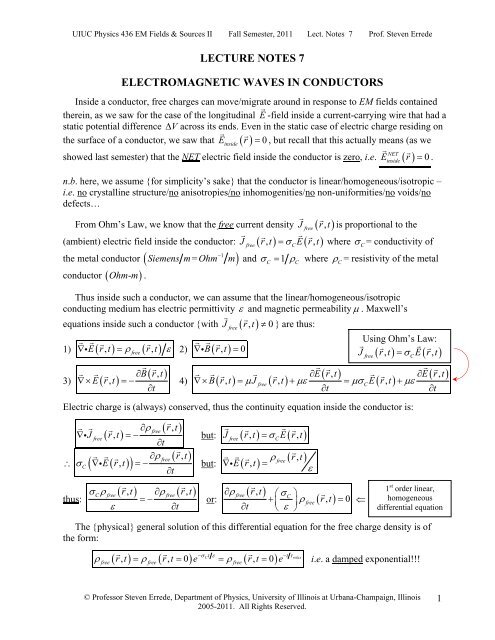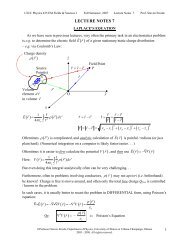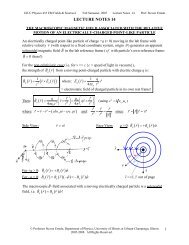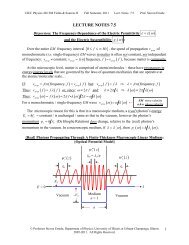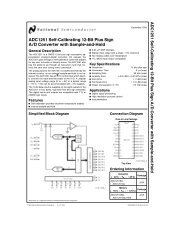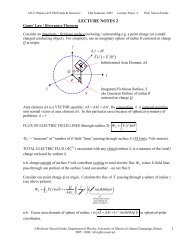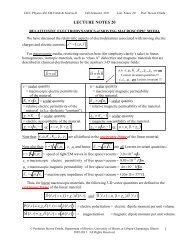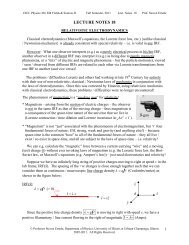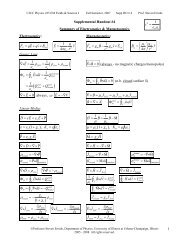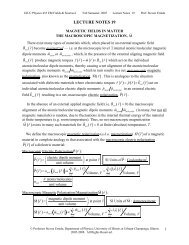Lecture Notes 07 - University of Illinois High Energy Physics
Lecture Notes 07 - University of Illinois High Energy Physics
Lecture Notes 07 - University of Illinois High Energy Physics
You also want an ePaper? Increase the reach of your titles
YUMPU automatically turns print PDFs into web optimized ePapers that Google loves.
UIUC <strong>Physics</strong> 436 EM Fields & Sources II Fall Semester, 2011 Lect. <strong>Notes</strong> 7 Pr<strong>of</strong>. Steven Errede−12Thus, after many charge relaxation time constants, e.g. 20τ relax≤Δ t 1 ps=10 sec, thenρfreert , ≥Δ t = 0 from then onwards}:Maxwell’s equations for a conductor become {with ( ) ∇ , = 01) ∇ i E( r, t)= 02) i B( r t) ∂B rt∇× =−∂t3) E( r,t)( , ) ∂E( r, t)⎛ ∂E r,t∇× B r, t = μσCE r, t + με = μ σCE( r,t)+ ε∂t⎜⎝∂t4) ( ) ( )Now because these equations are different from the previous derivation(s) <strong>of</strong> monochromaticplane EM waves propagating in free space/vacuum and/or in linear/homogeneous/isotropic nonconductingmaterials {n.b. only equation 4) has changed}, we re-derive the wave equations forE&B∇× to equations 3) and 4): from scratch. As before, we apply ( ) ∂ ∇× ( ∇× E) =− ( ∇× B)∇× ( ∇× B) = μ σC( ∇× E)+ ε ∂ ∇× E∂t∂t 2 ∂ ⎛ ∂E⎞ 22 ∂B∂ B= ∇( ∇iE) −∇ E =− ⎜μσCE+με ⎟ = ∇( ∇iB) −∇ B =−μσC−με2∂t⎝∂t⎠∂t∂t 22 ∂ E ∂E22 ∂ B ∂B= ∇ E = με + μσ2 C= ∇ B = με + μσ2 C∂t∂t∂t∂t2 22 ∂ E( r, t) ∂E( r,t)2 ∂ B( rt , ) ∂Brt( , )Again: ∇ E( r, t)= με + μσ2C and: ∇ B( r, t)= με + μσ2C∂t∂t∂t∂t Note that these 3-D wave equations for E and B in a conductor have an additional term thathas a single time derivative – which is analogous to a velocity-dependent damping term,e.g. for a mechanical harmonic oscillator.( )( ) ( )The general solution(s) to the above wave equations are usually in the form <strong>of</strong> an oscillatoryfunction * a damping term (i.e. a decaying exponential) – in the direction <strong>of</strong> the propagation <strong>of</strong> the EM wave, e.g. complex plane-wave type solutions for E and B associated with the abovewave equation(s) are <strong>of</strong> the general form:E z t( , )ikz ( −ωt)= E eo ikz ( −ωt)⎛ k ⎞ ˆ 1 B zt , = Beo= ⎜ ⎟k× E zt , = k×E zt ,⎝ω⎠ωand: ( )with {frequency-dependent} complex wave number: k( ω) = k( ω) + iκ( ω)where k( ω) =Re k ( ω)and κ( ω) m k( ω)( ) k k kˆk zˆ(in the ẑ( ω) = ( ω) = ( ω)( )Maxwell’s equations for acharge-equilibrated conductor( ) ( )=I and corresponding complex wave vector k ω = ( k ω + iκ ω )ˆ z.+ direction here), i.e. ( ) ( ) ( )⎞⎟⎠© Pr<strong>of</strong>essor Steven Errede, Department <strong>of</strong> <strong>Physics</strong>, <strong>University</strong> <strong>of</strong> <strong>Illinois</strong> at Urbana-Champaign, <strong>Illinois</strong>2005-2011. All Rights Reserved.3
UIUC <strong>Physics</strong> 436 EM Fields & Sources II Fall Semester, 2011 Lect. <strong>Notes</strong> 7 Pr<strong>of</strong>. Steven ErredeThis can be rewritten as:k⎡1( )μ 2σ 2 2 ⎤Cω⎡ 2 21 ( σ )⎤⎢ ⎥ 2 1⎡C2 σ ⎤C= μεω 1∓1+4( μεω ) ⎢1 1 ⎥ ⎛ ⎞( ) 1 12 ⎢ μεω24 μ 2 42⎥ = ∓ + = ⎢ ∓ + ⎥2 2( εω )2 ⎢ ( εω)⎥ ⎜ ⎟2 ⎢ ⎝εω⎢ ⎥⎠ ⎥⎣⎦ ⎣⎦ ⎣ ⎦2 2( )2Now we can see that on physical grounds ( k > 0 ), we must select the + sign, hence:k21⎡⎛σC ⎞⎤= ( μεω ) ⎢1+ 1+ ⎜ ⎟ ⎥2 ⎢ ⎝εω⎠ ⎥⎣⎦2 2and thus:k12 122 22 εμ⎡⎛σC⎞⎤εμ⎡⎛σC⎞⎤= k = ω ⎢1+ 1+ ⎥ = ω ⎢ 1+ + 1⎥⎜ ⎟ ⎜ ⎟2 ⎢ ⎝εω⎠ ⎥ 2 ⎢ ⎝εω⎠ ⎥⎣ ⎦ ⎣ ⎦2Having thus solved for k (or equivalently, k ), then we can use either <strong>of</strong> our original two2 2 2relations to solve for κ , e.g. k − κ = μεω , then:2 22 2 2 1⎡2 ⎛σC⎞⎤2 1⎡2 ⎛σC⎞⎤κ = k − μεω = ( μεω ) ⎢1+ 1+ ⎜ ⎟ ⎥− μεω = ( μεω ) ⎢ 1+ ⎜ ⎟ −1⎥2 ⎢ ⎝εω⎠ ⎥ 2 ⎢ ⎝εω⎠ ⎥⎣ ⎦ ⎣ ⎦Thus, we obtain:k( )εμ⎡2 ⎢⎣⎛σ⎞⎜ ⎟⎝εω⎠C( ω) =R e k ( ω)= ω ⎢ 1+ + 1⎥and: ( ) m k( )Note that the imaginary part <strong>of</strong> k , κ =Im( k)the monochromatic plane EM wave with increasing z:E z t = E e e( , )o−κ z ikz ( −ωt)2and: ( )⎤⎥⎦1 22εμ⎡⎛σC ⎞⎤κ ω =I ( ω ) = ω ⎢ 1+ ⎜ ⎟ −1⎥2 ⎢ ⎝εω⎠ ⎥⎣⎦ results in an exponential attenuation/damping <strong>of</strong> ( ) 1 −κz−ω 1 −κzB z, t = Boe e = k× E( z,t)= k×Eoe eωω( −ω)ikz t ikz tn.b. these solutions satisfy the above wave equations for any choice <strong>of</strong>The characteristic distance over whichE o . E and B are attenuated/reduced to11 e= e − = 0.3679δ ω ≡ 1 κ ω (SI units: meters).<strong>of</strong> their initial values (at z = 0) is known as the skin depth, ( ) ( )sc1 2i.e. δ ( ω)sc1 1= =κ( ω)2εμ⎡ σ ⎤Cω ⎢⎛ ⎞1+ ⎜ ⎟ −1⎥2 ⎢ ⎝εω⎠ ⎥⎣⎦1 2⇒( δ , )−1ikzE z =sct = Eoe e( δ , )−1ikzB z =sct = Boe e( −ωt)( −ωt)© Pr<strong>of</strong>essor Steven Errede, Department <strong>of</strong> <strong>Physics</strong>, <strong>University</strong> <strong>of</strong> <strong>Illinois</strong> at Urbana-Champaign, <strong>Illinois</strong>2005-2011. All Rights Reserved.5
UIUC <strong>Physics</strong> 436 EM Fields & Sources II Fall Semester, 2011 Lect. <strong>Notes</strong> 7 Pr<strong>of</strong>. Steven Errede( )The real part <strong>of</strong> k , i.e. k( ω) =Re k ( ω)determines the spatial wavelength λ ( ω ),the propagation speed v( ω ) <strong>of</strong> the monochromatic EM plane wave in the conductor, and also theindex <strong>of</strong> refraction:2π2πλ( ω)= =k R v( ω)and: n( ω)( )( ω) e k( ω)ω ω= =k R ( )( ω) e k( ω)( )()( ω) cRe k( ω)c ck= = =v ω ω ωThe above plane wave solutions satisfy the above wave equations(s) for any choice <strong>of</strong> E o .As we have also seen before, it can similarly be shown here that Maxwell’s equations 1) and 2) ( ∇ iE= 0 and ∇ i B=0)rule out the presence <strong>of</strong> any {longitudinal} z-components for E and B (for EM waves propagating in the + ẑ -direction) ⇒ E and B are purely transverse waves(as before), even in a conductor!If we consider e.g. a linearly polarized monochromatic plane EM wave propagating in thez ikz ( tẑE −κ −ωz,t = E e e )ˆ x , then:+ -direction in a conducting medium, e.g. ( ) 1 ⎛ k⎞−κzikz ( −ωt) ⎛k+iκ⎞ −κzikz ( −ωt)B ( zt , ) = k× E( zt , ) = ⎜ ⎟Ee ˆˆoe y=⎜ ⎟Ee oe yω ⎝ω⎠⎝ ω ⎠⇒ E( z, t) ⊥ B( z,t) ⊥ zˆ( + ẑ = propagation direction)oThe complex wavenumber = + = where:ik k ik Ke φ 2 2and ( )−1φk≡ tan κK ≡ k = k + κkIn the complex k -plane:()κ = Im kκ Kφk k = Re( k)k2 2K = k= k + κ6© Pr<strong>of</strong>essor Steven Errede, Department <strong>of</strong> <strong>Physics</strong>, <strong>University</strong> <strong>of</strong> <strong>Illinois</strong> at Urbana-Champaign, <strong>Illinois</strong>2005-2011. All Rights Reserved.
UIUC <strong>Physics</strong> 436 EM Fields & Sources II Fall Semester, 2011 Lect. <strong>Notes</strong> 7 Pr<strong>of</strong>. Steven ErredeThen we see that: ( , )and that: ( , )z ikz ( tE −κ −ωzt = Ee e )ˆ x has: iE = E e δEo −κzi( kz−ωt) k −κzi( kz−ωt)has:B zt = Be ˆ ˆ0e y= Eeoe yω io ok = Ke φki ki kφKeBB δo= Beo= Eo= Eeoω ωiφk2 2iδ Ke iδ K i( δ + φ ) k + κ i( δ + φ )Thus, we see that: Be = Ee = Ee = Eeω ω ω i.e., inside a conductor, E and B are no longer in phase with each other!!!Phases <strong>of</strong> E and B : δ = δ + φB E kBBE k E ko o o oWith phase difference: ΔϕB−E ≡δB− δE= φk⇐ magnetic field lags behind electric field!!!2BoK⎡⎛σC ⎞⎤1We also see that: = = ⎢εμ1+ ⎜ ⎟ ⎥ ≠Eoω ⎢ ⎝εω⎠ ⎥ c⎣⎦ The real/physical E and B fields associated with linearly polarized monochromatic planeEM waves propagating in a conducting medium are exponentially damped:( ) ( ) ˆ −κz( , ) =R ( , ) =ocos − ω + δEδ = δ + φB E kE zt e E zt Ee kz t x( ) ( )1 2B zt , =R e B zt , = Be cos kz− t+ y= Be cos kz− t+ + yˆ−κz−κz( ) ( ) ˆoω δB oω { δE φk}( )δi EBEooK ( ω)⎡⎛σC ⎞= = ⎢εμ1+ ⎜ ⎟ω ⎢ ⎝εω⎣⎠2⎤⎥⎥⎦12⎡⎛σC ⎞ω ≡ ω = ω + κ ω = ω⎢εμ1+ ⎜ ⎟⎢ ⎝εω⎣⎠2 2where K( ) k( ) k ( ) ( )2⎤⎥⎥⎦1 2δBδE φk= + , φ ( ω)k( )( ω)⎛ −1κ ω ⎞≡ tan⎜k ⎟⎝ ⎠Definition <strong>of</strong> the skin depth δ ( )sc and k( ω) = k( ω) + iκ( ω)z , k( ) ω = k( ω) = k( ω) + iκ( ω)ω in a conductor:( )ˆδsc( ω)1 1≡ =κ( ω)2εμ⎡ σ ⎤Cω ⎢⎛ ⎞1+ ⎜ ⎟ −1⎥2 ⎢ ⎝εω⎠ ⎥⎣⎦1 2=Distance over which the E and B fields fall to11 e= e − = 0.3679 <strong>of</strong>their initial values.The instantaneous power per unit volume in the conductor {ultimately dissipated as heat!} is: − κp z, t = J z, t iE z, t = σ E z, t iE z, t = σ E z, t = E e z cos kz− ωt+δ Watts m2 2 2 2 3( ) ( ) ( ) C ( ) ( ) C ( ) o ( E) ( )p zt ,1 2 2The time-averaged power per unit volume in the conductor is thus: ( ) −t=2zEe κo© Pr<strong>of</strong>essor Steven Errede, Department <strong>of</strong> <strong>Physics</strong>, <strong>University</strong> <strong>of</strong> <strong>Illinois</strong> at Urbana-Champaign, <strong>Illinois</strong>2005-2011. All Rights Reserved.7
UIUC <strong>Physics</strong> 436 EM Fields & Sources II Fall Semester, 2011 Lect. <strong>Notes</strong> 7 Pr<strong>of</strong>. Steven ErredeSpecial/Limiting Cases:a) Good conductors: σCSince k = k+ik and σC εω Conductivity <strong>of</strong> good conductor σ → ∞ ( ie .. ρ = 1σ→ 0).σ C⎛ ⎞ εω , i.e. ⎜ 1⎟⎝εω ⎠then:1 12 212 2 2C C CC C Cεμ⎡⎛σ ⎞⎤εμ⎡⎛σ ⎞⎤εμ ⎡ σ ⎤ ε μσk ≡ ω ⎢ 1+ ⎜ ⎟ + 1⎥ ω ⎢ 1+ ⎜ ⎟ ⎥ ω ⎢ ⎥ = ωCωμσ C2 ⎢ ⎝εω ⎠ ⎥ 2 ⎢ ⎝εω ⎠ ⎥ 2 ⎣ εω⎣ ⎦ ⎣ ⎦⎦ 2 ε ω = 2and:1 12 212 2 2C C Cεμ⎡⎛σ ⎞⎤εμ⎡⎛σ ⎞⎤εμ ⎡ σ ⎤ ε μσκ ≡ ω ⎢ 1+ ⎜ ⎟ − 1⎥ ω ⎢ 1+ ⎜ ⎟ ⎥ ω ⎢ ⎥ = ωCωμσ C2 ⎢ ⎝εω ⎠ ⎥ 2 ⎢ ⎝εω ⎠ ⎥ 2 ⎣ εω⎣ ⎦ ⎣ ⎦⎦ 2 ε ω = 2∴ In a good conductorσC εω :kωμσ2C( ω) κ( ω) and skin depth: δ ( ω)sc≡ 1 2κ ω ωμσ.( )C8© Pr<strong>of</strong>essor Steven Errede, Department <strong>of</strong> <strong>Physics</strong>, <strong>University</strong> <strong>of</strong> <strong>Illinois</strong> at Urbana-Champaign, <strong>Illinois</strong>2005-2011. All Rights Reserved.
UIUC <strong>Physics</strong> 436 EM Fields & Sources II Fall Semester, 2011 Lect. <strong>Notes</strong> 7 Pr<strong>of</strong>. Steven ErredeFORMULAS FOR EM WAVE PROPAGATION IN A GOOD CONDUCTORkωμσ2C( ω) κ( ω) and: δ ( ω)2πWavenumber, k ( ω)≡ ⇒ ( )λ ( ω)n.b. in a perfect conductor:⇒ ( ) ( )CCsc1 2= skin depth ≡ κ ω ωμσ( ) ( )( )2π2π2λ ω = = 2πδsc( ω)= 2πk ω κ ω ωμσσ = ∞ φ ( ω) ( δ δ )k B E( )( ω)⎛κ ω ⎞≡ − ≡ ⎜k ⎟⎝ ⎠ωμσ−1 πk ω κ ω = =∞ But: tan () 1 = 45 =242π πλ ω = = 0⇒ φ = δB− δE= 45 =k ω4⇒ ( )δsc( ω)( )( )= 1 2 0κ ω ωμσ=⇒ B lagsCCC()−1 −1tan tan 1E by 45 in a good conductor. πn.b. In a perfect conductor: σC=∞, φ ≡ 45 =4In a typical good conductor (e.g. gold/silver/copper/…): ( σ εω) 116For optical frequencies/visible light region: ω 10 radians sec . A good conductor typically has7σC 10 Siemens m and ε 3εo , and at optical frequencies: ( ) 37.7 1Cσ εω is satisfied.If the conductor is non-magnetic (e.g. copper, aluminum, gold, silver, platinum… etc.)−7⇒ μ μ = 4π×10 Henrys/m .Then: k ( ω) κ( ω)o116 −7 7 2ωμσCωμoσ ⎡C10 × 4π× 10 × 10 ⎤8 ≈ = 2.51×10 radians/m2 2⎢2⎥ ⎣⎦−8λ ω = 2π k ω = wavelength in good conductor 2.51× 10 m=25.1 nmAnd: ( ) ( )82π 2πcc 2π× 3×10−7cf w/ vacuum wavelength: λo= = = = 1.885× 10 m=188.5 nm16k ω f 10goodvacuum⇒ λ( ω) 25.1 nm( conductor ) λo= 188.5 nm( wavelength )o⎛ λ ⎞o188.5 nmVacuum/conductor λ-ratio:⎜= 7.52λ( ω)⎟ at optical frequencies,⎝ ⎠ 25.1 nm1 λ( ω) −9Skin depth: δsc ( ω)= 4.0× 10 m=4.0 nm !!!κ( ω)2π⇒ This explains why metals are opaque at optical frequencies,{and also explains why/how silvered sunglasses work!}C16ω ≈ 10 radians/sec16ω ≈ 10 rad/sec.© Pr<strong>of</strong>essor Steven Errede, Department <strong>of</strong> <strong>Physics</strong>, <strong>University</strong> <strong>of</strong> <strong>Illinois</strong> at Urbana-Champaign, <strong>Illinois</strong>2005-2011. All Rights Reserved.9
UIUC <strong>Physics</strong> 436 EM Fields & Sources II Fall Semester, 2011 Lect. <strong>Notes</strong> 7 Pr<strong>of</strong>. Steven ErredeCompare these results for EM waves propagating in conductors at optical frequencies to thosefor EM waves propagating in conductors, but with very low frequencies – e.g. the AC linefrequency, f = 60 Hz ⇒ ω = 2π f = 120 π rad/sec , where the criterion for a goodACconductor, ( )15ACσ εω 10 1 is certainly well-satisfied:CACf−7 7⎧ ωμσ ⎡C120π× 4π× 10 × 10 ⎤kACκAC⎪ = 48.7 /2⎢2⎥ = radians m⎪⎣⎦⎪ 2π⎪λAC= = 0.129 m=12.9 cmk⎪λ = × m⎪6⎪λo5×10 mAC7= 3.87×10 !!⎪ λAC0.129 m⎪⎪AC λAC−260 Hz AC skin depth: δsc= 2.05× 10 m=2.05 cm!!⎪⎩2π6At = 60Hz: ⎨ o5 10 !!AC⇒ Need at least 3-4× ≈ several → 10 cm to screen out unwanted 60 Hz AC signals !!δsc⎛ ⎞Instantaneous EM Wave <strong>Energy</strong> Densities in a Good Conductor: ⎜ ⎟ 1⎝εω⎠ EM EM ⎛1 2⎞ ⎛ 1 2⎞ ⎛1 ⎞⎛ 1 π⎞ φk ≡ δB − δE =uEM = uE + uM= ⎜ εE ⎟+ ⎜ B ⎟= ⎜ εEiE⎟+⎜ BiB⎟⎝2 ⎠ ⎝2μ⎠ ⎝2 ⎠ ⎝2μ⎠ {in a good conductor}−κE z, t E e z−κ= cos kz− ωt+δ x B zt , = Be z cos kz− ωt+ δ + φ y( ) ( ) ˆWhere:o12 2K ( )⎡⎤⎢⎛ C ⎞o oεμ 1 ⎥oEω σ ε μσCB = E = + ⎜ ⎟ E ω ⎢ ⎝εω⎠ ⎥ ε ω⎣⎦And: k ( ω) ( )Then:v( ω)ωμσC κ ω ≈ ,2σ Cand ( ) ( ) ˆω ω 2ωc= = = for a good conductor.k( ω) ωμσ ωσCCn( ω)2oE( ) 445μσC= E o for a good conductor,ω1 1 EM1( ) 2 2 −, 2 κ zu cos2Ez t = ε E = εEi E = εEoe ( kz− ωt+δE)and:2 2 21 1 EM 12 2 −, 2 κz σcos 2 C 2 − 2 κzu cos2Mz t = B = BiB= Boe kz− ωt+ δE + φk Eoe kz− ωt+ δE + φk2μ 2μ 2μ 2ω( ) ( ) ( )10© Pr<strong>of</strong>essor Steven Errede, Department <strong>of</strong> <strong>Physics</strong>, <strong>University</strong> <strong>of</strong> <strong>Illinois</strong> at Urbana-Champaign, <strong>Illinois</strong>2005-2011. All Rights Reserved.
UIUC <strong>Physics</strong> 436 EM Fields & Sources II Fall Semester, 2011 Lect. <strong>Notes</strong> 7 Pr<strong>of</strong>. Steven Errede1≡τ ∫τu z t dtTime-averaging these quantities over one complete cycle: u( z, t) ( , )1 2 2 1 τ− κ z21 2 −2zu ( z, t) = ε E e cos ( kz− ωt+ δ ) dτ= ε Eeo∫κ4EME2oτ0E1=2σ 2 2 1 τC − κ z21 ⎛σC ⎞ 2 −2zu ( z, t) = E e cos ( kz− ωt+ δ + φ ) dτ= ⎜ ⎟Ee o∫κ4 ⎝ ω ⎠EMM2ωoτ0E k1=2EM EM EM 1 ⎛ σ ⎞ zuTot z, t = uE z, t + uM z, t = ε ⎜1+⎟Eoe κ4 ⎝ εω ⎠C 2 −2∴ ( ) ( ) ( )σ C⎛ ⎞But: ⎜ ⎟ 1εω1⎛σ⎞⎡1zu z,t ε E e κ ⎤ ⎜⎝⎟⎢⎠⎣⎥⎦⎝ ⎠ for a good conductor, ⇒ EM( ) C2 −2Toto2 εω 2( z,t)( z,t)0n.b. Exponentially attenuated in z !!!EMuM⎛σC ⎞i.e. the ratio:= 1EM ⎜uεω ⎟E ⎝ ⎠ or EM( , ) EMu ( , )Mz t uEz t for a good conductor.⇒ Vast majority <strong>of</strong> EM wave energy is carried by the magnetic field in a good conductor !!!Poynting’s Vector: 1 S = E×Bμ 1 1κ zS z, t = E× B = E cos ˆoBoe φkzμ 2μ−2⇒ ( )πφk=4 1 1 κzKI z = S z, t = EoBoe − cosφk = Eoe− ⎛ ⎜ cosφ⎞k ⎟2μ 2μ ⎝ω⎠2κz2 2EM wave intensity (aka irradiance): ( ) ( )But:ωμσ C2KcosφkμσC= =ω ω ω 2ω 1 ⎛ k ⎞ 1 σI z = S z,t = ⎜ ⎟Eoe = Eoe2μ ⎝ω⎠2 2μω2 −2κzC 2 −2 ∴ ( ) ( )κzb.) Special/Limiting Case <strong>of</strong> a Fair Conductor:c.) Special/Limiting Case <strong>of</strong> a Poor Conductor: (i.e. an insulator):Here:σCσ C⎛ ⎞ εω , i.e. ⎜ ⎟ 1⎝εω⎠Complex wavenumber: k = k+iκσC≈ εω ⇒ Must use exact formulae! . Conductivity <strong>of</strong> poor conductor: σ 0 ( ie . . ρ 1 σ ) , with k = Re ( k ) and Im( k )κ = .→ = →∞ .C C Ck( )121 12 2 2 2 2C1C1Cεμ⎡⎛σ ⎞⎤εμ ⎡ ⎛σ ⎞ ⎤ εμ ⎡ ⎛σ⎞ ⎤ω ≡ ω ⎢ 1+ ⎜ ⎟ + 1⎥ω ⎢1+ ⎜ ⎟ + 1⎥ = ω ⎢2+⎜ ⎟ ⎥ ω εμ2 ⎢ ⎝εω ⎠ ⎥ 2 ⎢⎣ 2⎝εω ⎠ ⎥⎦ 2 ⎢⎣ 2⎝εω⎣⎦⎠ ⎥⎦∴ ( ) k ω ω εμ for a poor conductor.© Pr<strong>of</strong>essor Steven Errede, Department <strong>of</strong> <strong>Physics</strong>, <strong>University</strong> <strong>of</strong> <strong>Illinois</strong> at Urbana-Champaign, <strong>Illinois</strong>2005-2011. All Rights Reserved.11
UIUC <strong>Physics</strong> 436 EM Fields & Sources II Fall Semester, 2011 Lect. <strong>Notes</strong> 7 Pr<strong>of</strong>. Steven ErredeLikewise:1 21 2ε2εμ⎡ σ ⎤2⎛( ) 1 C ⎞εμ ⎡ 1κ ω ω ⎢1⎥⎛σ ≡ + ⎜ ⎟ − ω 1C ⎞ ⎤2μσ+ ⎜ ⎟ −1= ωC1 μ⎢⎥σ2 22 ⎢ ⎝εω⎠ ⎥ 2 2 εω⎣⎦ ⎢⎣⎝ ⎠ ⎥⎦4εω 2 C ε1 μ∴ κ( ω) σ for a poor conductor.2 C ε1μ⎛σ In a poor conductor C ⎞⎜ ⎟ 1⎝εω⎠ , the ratio: ⎛ 2σκ( ωC) ⎞ ε 1 ⎛σC ⎞⎜1k ( ω)⎟ = ⎜ ⎟ i.e. κ( ω) k ( ω).⎝ ⎠ ω εμ 2 ⎝εω⎠⇒ Complex wavenumber k ≡ k+iκ is primarily real, because κ k in a poor conductor.⎛1κ ω ⎞−−1⎛1⎛ωC⎞⎞1⎛σC⎞Phase angle in a poor conductor: φk ≡δB − δE= tan⎜tan 1k ( ω)⎟= ⎜ ⎜ ⎟⎟⎜ ⎟⎝ ⎠ ⎝2⎝εω⎠⎠2⎝εω⎠ ⇒ δ B= δ E+ φ k δ E, i.e. B and E are nearly in phase with each other in a poor conductor(i.e. losses very small in a poor conductor).In a typical poor conductor, e.g. pure water:Water has a huge static electric permittivity (due to permanent electric dipole moment <strong>of</strong>εHO 81ε at zero Hz, . . 02oie f = ( at P= 1 ATM and T = 20 C), however, at16−1210 rad sec ε ω ≈ 1.777ε, where ε o= 8.85× 10 Farads m .water molecule): ( )ω ≈ : ( )optical frequencies ( )H2O( )−7Since water is non-magnetic: μHOμo= 4π× 10 Henrys m⇒ index <strong>of</strong> refraction: ( ) ( )2n ω = ε ω μ ε μ 1.333 at optical frequencies.HO 2 HO 2 HO 2 o oHO 2 HO 2 5 −6The conductivity <strong>of</strong> pure water is: σC = 1 ρC 1 2.5× 10 Ω -m= 4.0×10 Siemens m−11( at P= 1 ATM and T = 20 C). Thus, the criteria for a poor conductor ( σCεω) 2.54×10 1is certainly satisfied at optical frequencies.The wavenumber in pure HO2at optical frequencies is:kHO 2( )ω ω εμ ≈ ω εμ = 10 1.777× 8.85× 4π× 10 4.45×10o16 −7 7oradians m−7The wavelength in pure HOis: λ 2 1.413 10 141.32 HO= π k2 HO= × m= nm at optical frequencies.2−7cf w/ the vacuum wavelength: λo = c f = 2πc ω = 1.885× 10 m=188.5 nm12© Pr<strong>of</strong>essor Steven Errede, Department <strong>of</strong> <strong>Physics</strong>, <strong>University</strong> <strong>of</strong> <strong>Illinois</strong> at Urbana-Champaign, <strong>Illinois</strong>2005-2011. All Rights Reserved.
UIUC <strong>Physics</strong> 436 EM Fields & Sources II Fall Semester, 2011 Lect. <strong>Notes</strong> 7 Pr<strong>of</strong>. Steven Errede⎛ λ ⎞o188.5 nmNote that the optical wavelength ratio: = = 1.333 = n⎜2λ ⎟⎝ HO141.3 nm2 ⎠since λ = λ n in a poor conductor!!!H2O o H2OH O,Skin depth: δ ( ω)sc≡ 1 1κ ω σ μεfor a poor conductor ⎛ ⎞⎜ ⎟⎝εω⎠ 1 .( )1For pure H 2 O at optical frequencies:1 μ 1 μ 1 1 4π×10κ ω σ σ2 ε 2 ε 2 ⎝2.5× 10 ⎠ 1.777× 8.85×102C−7o ⎛ ⎞−4HO( ) 5.65 102C≈C= ⎜× rad m5 ⎟−12σ CδHO 2sc( ω)1≡ = × m=κHO 231.7688 10 1.77kmn.b. neglects/ignores Rayleigh scattering process – visible lightvisphotons elastically scattering <strong>of</strong>f <strong>of</strong> H 2 O molecules. λ 10attenmRatio:1 μ⎛κ ( )CHOω ⎞ σ1 1 1 12 2 ε ⎛σC ⎞ ⎛ ⎞= = = = ×⎜ 5 −12 16k HO ( ω)⎟ ω εμ 2⎜εω⎟ ⎜ ⎟⎝⎝ ⎠ 2 ⎝2.5× 10 ⎠1.777× 8.85× 10 × 102 ⎠−111.27 10 1−1 HO 2−11Phase difference: φ ≡δ − δ = tan ⎜ ⎟ 1.27×10 radians ( 1)k B E⎛κ⎜⎝k HO 2⎞ i.e. δB= δE + φk δE⎟⎠ ⇒ B and E are nearly in phase with each other in pure H2 O at optical frequencies.For pure H 2 O at low frequencies – e.g. 60 Hz AC line frequency ( ω 2π f 120πrad sec)ACThe electric permittivity at f = 60 Hz is ε ( )HO 2AC= = :−12f 60Hz 80εo= 80× 8.85×10 Farads mAC−7HO 2 −6and μ μ = 4π×10 Henrys m. Conductivity <strong>of</strong> pure HO:2σ C= 4.0×10 Siemens mHO 2oACNote that the criteria for a poor conductor:⎛6σ ⎞−C4.0×1015 1AC ⎜ −12εHOω ⎟⎝80 8.85 10 1202 AC⎠× × ⋅ πis not satisfied at the 60 Hz AC line frequency – i.e. at low enough frequencies,even poor conductors such as pure water are actually quite good conductors !!!Thus, for the following, we must use the good conductor approximations:−7 −6ω μ σ ω μ σ 120π ⋅ 4π× 10 ⋅ 4×10≈ = = ×2 2 2HO 2HO 2 HO 2AC AC C AC o Ck AC ( ω) κ AC ( ω)λHO 2AC( ω)HO 2k AC( )−53.08 10 rads m 2π52.04 10 mω = × cf w/ vacuum wavelength: 2πc6λo= c fAC= = 5.00×10 mωAC© Pr<strong>of</strong>essor Steven Errede, Department <strong>of</strong> <strong>Physics</strong>, <strong>University</strong> <strong>of</strong> <strong>Illinois</strong> at Urbana-Champaign, <strong>Illinois</strong>2005-2011. All Rights Reserved.13
UIUC <strong>Physics</strong> 436 EM Fields & Sources II Fall Semester, 2011 Lect. <strong>Notes</strong> 7 Pr<strong>of</strong>. Steven ErredeVacuum/good conductor wavelength ratio:⎛ λ ⎞o5.00×10⎜ HO⎟=2⎝λAC⎠ 2.04×1065m 24.495mAC AC4Skin depth for pure H 2 O at 60 Hz AC line frequency: δHO≡ 1 κ 3.25 10 32.52 HO× m=km2This may seem like a large distance scale associated with the attenuation <strong>of</strong> the 60 Hz EMwaves propagating in pure water, however compare the skin depth to the wavelength at thisACHO 2 6AC ACfrequency: δ = 32.5 km vs. λ = 1.77× 10 m , i.e. we see that δ λ , as we expectHO 2for the case <strong>of</strong> a good conductor !!!AC ACThe ratio ( κHOkHO)2 2ACH2OH2O 1 for pure H 2 O at 60 Hz AC line frequency, which is what we expect fora good conductor {this ratio should be 1 for a poor conductor}.π≡ − = tan tan 1 = = 454which again is what we expect for a good conductor, i.e. B lags E by 45 o !− AC AC−Thus, the phase difference is: φ δ δ ( κ k ) ()1 1 ok B E H2O H2O⎛ ⎞Instantaneous EM energy densities in a poor conductor: ⎜ ⎟ 1⎝εω⎠ ⎛1 ⎞ ⎛ 1 ⎞ ⎛1 ⎞⎛ 1 ⎞= + = ⎜ ⎟+ ⎜ ⎟= ⎜ ⎟+⎜ ⎟⎝2 ⎠ ⎝2μ⎠ ⎝2 ⎠ ⎝2μ⎠EMEM( , ) ( , ) ( , )2 2uEM z t uE z t uMz t εE B εEiE BiBσ CThe physical E and B fields are:−κE z, t = E e z cos kz− ωt+δ x( ) ( ) ˆoE−κand B( zt , ) = Be z cos( kz− ωt+ δ + φ ) yˆo E k1 22K⎡ σ ⎤Cwhere: Bo E ⎢⎛ ⎞oεμ 1 ⎥⎛σ = = + ⎜ ⎟ Eo ≈ εμ E<strong>of</strong>or a poor conductor, C ⎞⎜ ⎟ 1ω ⎢ ⎝εω⎠ ⎥εω⎣⎦⎝ ⎠ .ω1k ω εμ = where: v cv= εμ= nand: εμn = for a poor conductor.εoμo1 μand: κ σ k ω εμ , K ≡ k ω εμ for a poor conductor.2 c ε1 1 1Eio E and:2 2 21 1 EM1( ) 2 2 −, 2 κ zu cos2Mz t = B = BiB= Boe ( kz− ωt+ δE + φk)2μ 2μ 2μEMThen: ( ) 2 2 − 2 κ zu z, t = ε E = cE E = εE e cos2( kz− ωt+δ )Time-averaging these quantities:EM 1uEz t Eoe κ41 z 1uMz t = Boe κ εμ4μ4 μ2 −2zEM2 −2( , ) = ε and: ( , )2 −2κz1 2 −2( ) Eeo= ε Eeo4κz14© Pr<strong>of</strong>essor Steven Errede, Department <strong>of</strong> <strong>Physics</strong>, <strong>University</strong> <strong>of</strong> <strong>Illinois</strong> at Urbana-Champaign, <strong>Illinois</strong>2005-2011. All Rights Reserved.
UIUC <strong>Physics</strong> 436 EM Fields & Sources II Fall Semester, 2011 Lect. <strong>Notes</strong> 7 Pr<strong>of</strong>. Steven Errede1 1 1uTot z, t = uE z, t + uM z,t εEo e + εEo e = εEoe4 4 22 −2 2 −2 2 −2∴ ( ) ( ) ( )EM EM E κ z κz κz1zuTotz,t Eoe κ⎛ ⎞= ε for a poor conductor ⎜ ⎟ 12⎝εω⎠ .EM2 −2Thus: ( )The ratio <strong>of</strong> {time-averaged} electric/magnetic energy densities for a poor conductor:1 2 −2κzEMu ( , )oEz t ε Ee4 κ = 1 φEMkδB δ⎛ ⎞− 1 μ≡ −E= ⎜ ⎟u ( , ) 1 2 2 zMz t− κε Ee⎝ ⎠o4 ⇒ EM wave energy is shared ≈ equally by the E and B fields in a poor conductor!σ C1 HO 2otan 1 κH⎜ k HO⎟2O σc kH2O ω εμo2 ε2Instantaneous Poynting’s Vector for EM waves propagating in a poor conductor: 1 S z t E z t B z tμ( , ) = ( , ) × ( , ) 1 ε κ zS z,t E ˆoe z for a poor conductor.2 μ2 −2∴ ( )oIntensity <strong>of</strong> EM waves propagating in a poor conductor: 1 ε 2 −2zI ( z) = S( z,t) = Eoe κ2 μo 1 εμS z, t = E z, t × B z, t E e cosφzˆμ2μo 2 −2κz⇒ ( ) ( ) ( ) oko≈1© Pr<strong>of</strong>essor Steven Errede, Department <strong>of</strong> <strong>Physics</strong>, <strong>University</strong> <strong>of</strong> <strong>Illinois</strong> at Urbana-Champaign, <strong>Illinois</strong>2005-2011. All Rights Reserved.15
UIUC <strong>Physics</strong> 436 EM Fields & Sources II Fall Semester, 2011 Lect. <strong>Notes</strong> 7 Pr<strong>of</strong>. Steven ErredeReflection <strong>of</strong> EM Waves at Normal Incidence from a Conducting Surface:In the presence <strong>of</strong> free surface charges σfreeand/or free surface currents, K freethe boundaryconditions obtained from (the integral forms <strong>of</strong>) Maxwell’s equations for reflection andrefraction at e.g. a dielectric-conductor interface become:BC 1): (normal D ⊥ ⊥at interface): ε1E1 − ε2E2 = σfreeBC 2): (tangential E at interface): E1 − E2 = 0E= E ⇒ 1 2⊥ = normal to plane <strong>of</strong> interface = parallel to plane <strong>of</strong> interfaceBC 3): (normal B ⊥ ⊥⊥at interface): B1 − B2 = 0 ⇒ B1 = B2⊥BC 4): (tangential H at interface):1 1 B − B = K ˆfree× nμ|| ||1 21μ2→21where ˆn → is a unit vector ⊥ to the interface, pointing from medium (2) into medium (1).21{n.b. do not confuse ˆn → with the EM wave polarization vector ˆn !!!}21 Note: For Ohmic conductors (i.e. “normal” conductors obeying Ohm’s Law Jfree= σCE)there can be no free surface currents, i.e. Kfree= 0 because Kfree≠ 0 would require an infiniteE -field at the boundary/interface!Suppose ∃ a boundary/interface (located in the x-y plane at z = 0) between a non-conductinglinear/homogeneous/isotropic medium (1) and a conductor (2). A monochromatic plane EMwave is incident on the interface, that is linearly polarized in + ˆx direction, traveling in the+ ẑ direction, approaching the interface/boundary from the left, in medium (1) as shown in thefigure below:16© Pr<strong>of</strong>essor Steven Errede, Department <strong>of</strong> <strong>Physics</strong>, <strong>University</strong> <strong>of</strong> <strong>Illinois</strong> at Urbana-Champaign, <strong>Illinois</strong>2005-2011. All Rights Reserved.
UIUC <strong>Physics</strong> 436 EM Fields & Sources II Fall Semester, 2011 Lect. <strong>Notes</strong> 7 Pr<strong>of</strong>. Steven Erredeikz ( 1 t)Incident EM wave {medium (1)}: E −ω( z,t)= E e xˆand: ( , )inci( k1z t)Reflected EM wave {medium (1)}: E − =ω( z,t)= E e xˆand: ( , )refloincoreflikz 1Binczt = Eoe yincv1 1 ikz (2 −ωt)Transmitted EM wave {medium (2)}: E ( z,t)= E e xˆand: ( , )transotransn.b. complex wavenumber in {conducting} medium (2): k2= k2 + iκ2 In medium (1) EM fields are: E ( z, t) = E ( z, t) + E ( z,t)Tot1inc reflIn medium (2) EM fields are: E ( z, t) = E ( z,t)Tot2transApply BC’s at the z = 0 interface in the x-y plane:( − −ω )i k1z tBreflzt =− Eoe yreflv1 k2ikz (2 −ωt)B ˆtranszt = Eoe ytransω and: B ( zt , ) = B ( zt , ) + B ( zt , )and: B ( zt , ) = B ( zt , )Tot2Tot1inc refl⊥ ⊥BC 1): ε1E1 − ε2E2 = σfree but: E⊥ 1= E 1= 0 and: E⊥ = E = 0 ∴ 0 − 0 = σ ⇒ σ 02 2 freefree=zztrans( )1B = k ˆ × Ev 1 ( −ωt)ˆˆ BC 2): E1 = E2E + E = E∴ o inc o refl o trans⊥ ⊥BC 3): B1 = B2but: B⊥ = 1B = 10 and: B⊥ = B = 0 ⇒ 0=02 2zBC 4):1 || 1 ||1k2B ˆ1− B2= Kfree× n→but: Kfree= 0 ∴ ( E o− E )inc o− Erefl otransμ211μ2μ1v1 μ2ω= 0or: E o− E inc o= β E ⎛μ1vk⎞ ⎛1 2μ1v⎞1refl oβ ≡ ⎜ ⎟=ktrans⎜ ⎟ 2⎝ μω2 ⎠ ⎝μω2 ⎠⎛1−Thus we obtain: Eβ ⎞o= Erefl⎜ ⎟2oinc⎝1+and: Eo= Etransoincβ ⎠( 1+ β )or:⎛E⎞o ⎛refl 1− β ⎞ ⎛E⎞o 2⎛μ⎟=⎜⎜ ⎟E⎟⎝o1+and:trans=1vkβinc ⎠ ⎝ ⎠⎜ Ewith: ⎞ ⎛1 2μ1v⎞1β ≡ k⎟⎝ o ( 1+⎜ ⎟=⎜ ⎟βinc ⎠ )⎝ μω2 ⎠ ⎝μω2 ⎠Note that these relations for reflection/transmission <strong>of</strong> EM waves at normal incidence on anon-conductor/conductor boundary/interface are identical to those obtained for reflection /transmission <strong>of</strong> EM waves at normal incidence on a boundary/interface between two nonconductors,except for the replacement <strong>of</strong> β with a now complex β for the present situation.z2© Pr<strong>of</strong>essor Steven Errede, Department <strong>of</strong> <strong>Physics</strong>, <strong>University</strong> <strong>of</strong> <strong>Illinois</strong> at Urbana-Champaign, <strong>Illinois</strong>2005-2011. All Rights Reserved.17
UIUC <strong>Physics</strong> 436 EM Fields & Sources II Fall Semester, 2011 Lect. <strong>Notes</strong> 7 Pr<strong>of</strong>. Steven ErredeFor the case <strong>of</strong> a perfect conductor, the conductivity σ = ∞ {thus resistivity, ρ = 1σ= 0}⇒ bothand since:ωμ2σCk2 κ 2 =∞ and since: k2 = k2 + iκ22⎛μ1vk⎞ ⎛1 2μ1v⎞1β ≡ ⎜ ⎟=k⎜ ⎟ 2 ⇒ β = ∞⎝ μω2 ⎠ ⎝μω2 ⎠C then: k = ∞+ i∞=∞ ( + i )C21Thus, for a perfect conductor, we see that: E o=−E andrefl oE = 0 and thus for a perfectinctransconductor the reflection and transmission coefficients are:C22 *⎛Eo ⎞ E ⎛refl oE ⎞⎛refl oE⎞refl oreflR ≡ = = ⎟⎜ = 1⎜ E ⎟oE ⎜inc oE ⎟⎜inc oE⎟⎝ ⎠ ⎝ inc ⎠⎝oinc⎠and: T = 1− R = 0We also see that for a perfect conductor, for normal incidence, the reflected wave undergoes a180 o phase shift with respect to the incident wave at the interface/boundary at z = 0 in the x-yplane. A perfect conductor screens out all EM waves from propagating in its interior.For the case <strong>of</strong> a good conductor, the conductivity σCis finite-large, but not infinite.The reflection coefficient R for monochromatic plane EM waves at normal incidence on a goodconductor is not unity, but close to it. {This is why good conductors make good mirrors!}For a good conductor:⎛Eo ⎞ E ⎛refl oE ⎞⎛refl oE ⎞refl orefl1− β ⎛1− β ⎞⎛1− β ⎞R ≡ = = ⎟⎜ = =⎜ E ⎟oE ⎜⎜ ⎟⎜ ⎟1 1 1inc oE ⎟⎜inc oE ⎟⎝ ⎠ ⎝ inc ⎠⎝o+ β + β + βinc ⎠⎝ ⎠⎝ ⎠2 2 *2 *Where:⎛μvk⎞ ⎛ μv⎞⎝ ⎠ ⎝ ⎠ 1 1 2 1 1≡ ⎜ ⎟=⎜ ⎟k2μω2μωand: k= k + iκ2 2 22β. For a good conductor:kκ2 2ωμ2σC2⎛ μv⎞ ⎛ μv⎞ ωμ σσ⎜ ⎟ 2 ⎜ ⎟1 1⎝μω 2 ⎠ ⎝μω 2 ⎠ 2 2μω2Thus: 1 1 1 1 2 CCβ = k = ( 1+ i) = μ v ( 1+i)Define: γ μ1v1σC2μ ω≡ Then: β = γ ( 1+i)2Thus, the reflection coefficient R for monochromatic plane EM waves at normal incidence ona good conductor is:with: γ ≡ μ1v12 2 * 2 2E o( 1refl 1− β ⎛1− β ⎞⎛1− β ⎞ ⎛1−γ −iγ ⎞⎛1− γ + iγ⎞ ⎡ − γ ) + γ ⎤R = = = =2 2E ⎜ ⎟⎜ ⎟ ⎜ ⎟⎜ ⎟=⎢ ⎥o1+ β 1+ β 1+ β 1+ γ + iγ 1+ γ −iγ( 1+ γinc⎝ ⎠⎝ ⎠ ⎝ ⎠⎝ ⎠ ⎢⎣ ) + γ ⎥⎦σC2μ ω218© Pr<strong>of</strong>essor Steven Errede, Department <strong>of</strong> <strong>Physics</strong>, <strong>University</strong> <strong>of</strong> <strong>Illinois</strong> at Urbana-Champaign, <strong>Illinois</strong>2005-2011. All Rights Reserved.
UIUC <strong>Physics</strong> 436 EM Fields & Sources II Fall Semester, 2011 Lect. <strong>Notes</strong> 7 Pr<strong>of</strong>. Steven ErredeObviously, only a small fraction <strong>of</strong> the normally-incident monochromatic plane EM wave istransmitted into the good conductor, since R < 1 and T = 1− R , i.e.:T( 1 γ)( 1 γ)2⎡2− + γ ⎤= 1− R= 1 −⎢ 12⎥2⎢⎣+ + γ ⎥⎦( )Note that the transmitted wave is exponentially attenuated in the z-direction; the E andB fields in the good conductor fall to 1/e <strong>of</strong> their initial {z = 0} values (at/on the interface) afterthe monochromatic plane EM wave propagates a distance <strong>of</strong> one skin depth in z into theconductor:δsc( ω)1 2≡ κ ω ωμ σ( )2 2Note also that the energy associated with the transmitted monochromatic plane EM wave isultimately dissipated in the conducting medium as heat.In {bulk} metals, since the transmitted wave is {rapidly} absorbed/attenuated in the metal, wecan only study/measure the reflection coefficient R. A full/detailed mathematical description <strong>of</strong> thephysics <strong>of</strong> reflection from the surface <strong>of</strong> a metal conductor as a function <strong>of</strong> angle <strong>of</strong> incidence i.e.k ω = ω v ω = ω c n ω withR ( ω, θinc ) requires the use <strong>of</strong> a complex dispersion relation ( ) ( ) ( ) ( )complex k ( ω) = k( ω) + iκ( ω)and complex propagation speed v ( ω ) = v ( ω ) + iv ( ω ) = c n( ω )with accompanying complex index <strong>of</strong> refraction n( ω) = n( ω) + iη ( ω), and thus is fairlycomplicated. So-called ellipsometry measurements <strong>of</strong> the EM radiation reflected from the surface<strong>of</strong> the metal as a function <strong>of</strong> angle <strong>of</strong> incidence yields information on the real and imaginary parts<strong>of</strong> the complex index <strong>of</strong> refraction <strong>of</strong> the metal n( ω) = n( ω) + iη( ω), and thus the real andimaginary parts <strong>of</strong> the complex dielectric constant and/or the complex electric susceptibility <strong>of</strong> the2n ω = ε ω ε = 1+ χ ω n ω = ε ω ε = 1+ χ ω .metal, since ( ) ( ) ( ) or ( ) ( ) ( )oeIf interested in learning more about this, e.g. please see/read Optics, M.V. Klein, p. 588-592,Wiley, 1970 {P436 reference book on reserve in the <strong>Physics</strong> library}. Please see/read also the UIUCP402 Optics/Light Lab Ellipsometry Lab Handout C4 and especially the references at the end.Available at: http://online.physics.uiuc.edu/courses/phys402/exp/C4/C4.pdfWe will discuss the dispersive nature <strong>of</strong> dielectric, non-conducting materials in the next lecture…Coe© Pr<strong>of</strong>essor Steven Errede, Department <strong>of</strong> <strong>Physics</strong>, <strong>University</strong> <strong>of</strong> <strong>Illinois</strong> at Urbana-Champaign, <strong>Illinois</strong>2005-2011. All Rights Reserved.19
UIUC <strong>Physics</strong> 436 EM Fields & Sources II Fall Semester, 2011 Lect. <strong>Notes</strong> 7 Pr<strong>of</strong>. Steven ErredeFull Maxwell Equations in Matter:The electromagnetic state <strong>of</strong> matter at a given observation point r at a given time t is describedby four macroscopic quantities:1.) The volume density <strong>of</strong> free charge: ρ free ( rt , ) 2.) The volume density <strong>of</strong> electric dipoles: P ( rt , ) ⇐ aka electric polarization 3.) The volume density <strong>of</strong> magnetic dipoles: M ( rt , ) ⇐ aka magnetization J r,t ⇐ aka {free} current density4.) The free electric current/unit area: ( )freeAll four <strong>of</strong> these quantities are macroscopically averaged - i.e. the microscopic fluctuationsdue to atomic/molecular makeup <strong>of</strong> matter have been smoothed out. The four above quantities are related to the macroscopic E and B fields by the four Maxwellequations for matter (see <strong>Physics</strong> 435 Lect. <strong>Notes</strong> 24, p. 14): 1i , where: ρboundεoεoD = ε E +Ρ & constitutive relation: D = ε E1) Gauss’ Law: ∇ TotE = ρ = ( ρ + freeρbound)Auxiliary relation:o = −∇ i Ρ ⎛ ε ⎞Electric polarization Ρ= ( ε − εo) E = ε0χeE, electric susceptibility χe= ⎜ −1⎟⎝εo ⎠∇ iD = εo∇ iE +∇ i Ρ= ρfree 2) No magnetic charges/monopoles: ∇ i B = 0 1 Auxiliary relation: H = B−Μ⇒ ∇ iH=−∇i M & constitutive relation: B = μHμo3) Faraday’s Law:B H MEμ0μ ∇× =− =− −0∂t ∂t ∂tMagnetization: ⎛ μ ⎞ ⎛ μ ⎞M − ⎜ ⎟H= χmH, magnetic susceptibility χm= ⎜ − 1 ⎟⎝μo−1⎠⎝μo⎠4) Ampere’s Law: ∇× B = μoJ ToT+ μoJED with JD= ε ∂o∂t mag P magP ∂PTotal current density: JToT = Jfree+ Jbound + JboundJbound= ∇× M J bound= ∂ t ∂P∂E∇× B= μoJfree+ μo∇× M + μo + μoεo∂t∂tDH μoJfreeμ ∂ ∇× = +o∂t20© Pr<strong>of</strong>essor Steven Errede, Department <strong>of</strong> <strong>Physics</strong>, <strong>University</strong> <strong>of</strong> <strong>Illinois</strong> at Urbana-Champaign, <strong>Illinois</strong>2005-2011. All Rights Reserved.
UIUC <strong>Physics</strong> 436 EM Fields & Sources II Fall Semester, 2011 Lect. <strong>Notes</strong> 7 Pr<strong>of</strong>. Steven ErredeWe also have Ohm’s Law: ∂ρJ = σCEand the 3 continuity eqn(s): Jα∇ iα=− ∂ tassociated withα = free, bound and total electric charge conservation.For many/most (but not all!!!) physics problems, e.g. in optics/condensed matter physics,materials <strong>of</strong> interest are frequently non-magnetic (or negligibly magnetic) and have no (free) charge densities present, i.e. ρfree= 0. If μ μo, then M = 0 and thus H = B μoin suchnon-magnetic materials.Then Maxwell’s equations in matter, for ρfree= 0 and M = 0 reduce to: 1) Gauss’ Law: ∇ i D = 0 or: 2) No magnetic charges: ∇ i B = 0 1 ∇ iE =− ∇ i P = ρfreeεoε ∂B3) Faraday’s Law: ∇× E =− ∂ t E P4) Ampere’s Law: B με ∂o o o oJfreetμ ∂∇× = + +∂ ∂tμ We also have Ohm’s Law Jfree= σcEand the Continuity eqn. ∇ i J free= 0 {here}.Then applying the curl operator to Faraday’s Law: 2 2∂ ∂ E ∂ P ∂J free1 ∇× ( ∇× E) =− ( ∇× B) =−με −μ − μ =∇2 2( ∇iE)−∇ E = ∇ρ−∇ E∂t ∂t ∂t ∂to2 2o o o o boundεoWe thus obtain the inhomogeneous wave equation:∂ E2 22 1 1 P free∇ E − = ∇ ρ2 2 bound+ μo + μ2 oc ∂ t εo∂ t ∂ t∂source terms∂J{and a similar/analogous one for B }For nonconducting/poorly-conducting media, i.e. insulators/dielectrics, the first two terms onthe RHS <strong>of</strong> the above equation are important – e.g. they explain many optical effects such asdispersion (wavelength/frequency-dependence <strong>of</strong> the index <strong>of</strong> refraction), absorption, double –refraction/bi-refringence, optical activity, . . . . Note that the ∇ ρ bound=−∇( ∇ i P)term is <strong>of</strong>ten zero, e.g. if the electric polarization P is uniform, ∂P∂Px y ∂Pz∂ ∂ ∂or since: ∇ i P = + + and ∇= xˆ + yˆ + zˆ∂x ∂y ∂z∂x ∂y ∂z e.g. for P ∝ E (i.e. P proportional to E) where: E( z, t) = E cos( kz− ωt+δ ) xˆo© Pr<strong>of</strong>essor Steven Errede, Department <strong>of</strong> <strong>Physics</strong>, <strong>University</strong> <strong>of</strong> <strong>Illinois</strong> at Urbana-Champaign, <strong>Illinois</strong>2005-2011. All Rights Reserved.21
UIUC <strong>Physics</strong> 436 EM Fields & Sources II Fall Semester, 2011 Lect. <strong>Notes</strong> 7 Pr<strong>of</strong>. Steven Errede∂Jfree ∂EFor good conductors (e.g. metals), the conduction term μo = μoσC∂t∂tis the most important, because it explains the opacity <strong>of</strong> metals (e.g. in the visible light region)and also explains the high reflectance <strong>of</strong> metals.All source terms on the RHS <strong>of</strong> the above inhomogeneous wave equation are <strong>of</strong> importancefor semiconductors – however a proper/more complete physics description <strong>of</strong> EM wavepropagation in semiconductors also requires the addition <strong>of</strong> quantum theory for rigoroustreatment…22© Pr<strong>of</strong>essor Steven Errede, Department <strong>of</strong> <strong>Physics</strong>, <strong>University</strong> <strong>of</strong> <strong>Illinois</strong> at Urbana-Champaign, <strong>Illinois</strong>2005-2011. All Rights Reserved.


